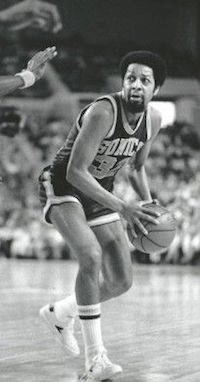
Fred Brown, who is also known as “Downtown Freddie Brown,” is a retired American professional basketball player in the National Basketball Association (NBA). Brown played for the University of Iowa before being drafted in 1971 by the Seattle Supersonics with whom he played for thirteen seasons (1971–1984). Known for his accurate outside shooting, Brown was selected to the 1976 NBA All-Star Game and scored 14,018 points in his career which included winning an NBA championship with the Supersonics in 1979.
Fred Brown was born on August 7, 1948, in Milwaukee, Wisconsin. He attended Lincoln High School in Milwaukee and led its basketball team to two state titles. He also made all-state twice. Brown was captain of the 1967 basketball team and earned four prep letters, including one each in football and basketball. Due to his outside shooting skills, he earned the nickname “Downtown Freddie Brown” which followed him his entire career.
After graduating from Lincoln High School in 1967, Brown attended Southeastern Community College Iowa from 1967 to 1969 before transferring to the University of Iowa in 1969 where he played for the Iowa Hawkeyes men’s basketball team. Brown finished his senior year in 1971 averaging 27.6 points per game. He was selected by the Kentucky Colonels in the American Basketball Association draft and selected sixth overall by the Seattle Supersonics in the NBA draft.
Brown’s NBA career got off to a slow start. In his rookie season, he averaged 4.2 points in the thirty-three games while playing behind veteran guards Lenny Wilkens and Dick Snyder. During his sophomore season in 1972, Brown saw more playing time following Wilkens’s trade to the Cleveland Cavaliers. His scoring average rose to 13.5 and 16.5 points per game in the next two seasons.
After teammate Snyder was traded to the Cavaliers in 1974, Brown’s output increased again to 21.0 points per game in the 1974–75 season, and he finished fifth in the league in steals per game. In the 1975–1976 season, Brown had an All-Star season, finishing fifth in the NBA in both scoring average and free throw percentage, along with making it into the All-Star game in 1976.
Brown continued to start for the Supersonics through the 1976–77 and 1977–78 seasons. During the 1978–79 season, Lenny Wilkens who took over as the Supersonics coach, paired new free agents, Gus Williams and Dennis Johnson, as the starting backcourt of the team and brought Brown off the bench. The Supersonics made it to the NBA finals that season, beating the Washington Bullets (now Washington Wizards) in five games to win their only NBA championship in 1979.
In 1979–1980, Brown led the NBA in three-point shooting percentage which was the first season that the three-point was adopted by the league. Brown retired from the NBA in 1984. At retirement, he was the Supersonics’ all-time leader in games played (963), points scored (14,018), field goals (6,006), and free throws (1,896). Brown’s number 32 jersey was retired in 1986 in honor of his career with the Supersonics.
After his NBA career ended, Brown entered a career of banking and became a small business executive and senior vice president at Bank of America. Brown is married to Linda Brown. They met when both were students at the University of Iowa.

